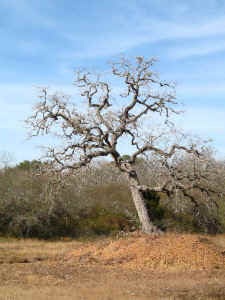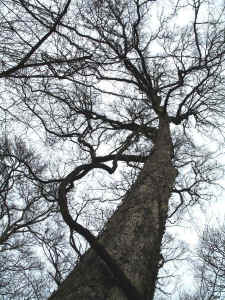Around the holidays my wife and I visited her family in Texas.
We decided to drive (don't ask), it's fantastic to watch the
scenery change between the mountains of NC all the way to the
hill country around Austin. (photos by Michael Davie)

Part of the Treaty Oak in Austin
The landscape in that part of Texas
is beautiful, miles and miles of gnarly, picturesque oaks being
the dominant feature. Escarpment live oaks are small versions of
their coastal cousins, and while most don't get very large, most
do get alot of character. As do the post oaks and bur oaks that
dominate the hill country. Post oaks seem to be the most common
tree in that part of Texas, but it's hard to say.

Typical bur oak in Texas hill country
Bur oaks are
more scattered; it is so strange to me to see the trees I
remember as a child- usually huge, spreading and massive- being
so stunted and gnarly beyond belief. Cedar elms are another
great tree around there, with chunky textured bark, super gnarl,
and tiny twigs and leaves. That's the only area I've ever been
where they are common, although they do extend up through
Arkansas to the southern corner of Tennessee. Ashe juniper
dominates the understory, in some places to a fault, due to it's
allelopathy. Along the creeks and rivers of the hill country you
might more commonly see cottonwoods, baldcypress, pecan,
sycamore, and the Texas persimmon, a really cool little tree
reminiscent of crape myrtle, with white bark and usually
multi-stemmed form. I also saw black cherry and hophornbeam,
both (I guess) a little south of the middle of their
ridiculously huge north-south ranges. I love seeing trees in
bony dry Texas I've seen in jolly green New England. I can't
wait to hit the mountains of Mexico or Honduras someday to see
them. I also got to see osage-orange in it's native range, and
the beautiful mesquite tree.

A panorama of Pedernales Falls State Park near Austin
On our way
back from Texas, I talked my wife into a brief (3 hour tour)
stop at Meeman-Shelby Forest State Park. It is a 13,467 acre
park on the East Bank of the Mississippi River North of Memphis.
Most of the park is designated a "State Natural Area".
From the SNA website:
"Meeman-Shelby Forest State Natural Area is one of
the largest contiguous tracts of mature bottomland hardwood
forest and Chickasaw Bluff forest left in Tennessee. The natural
area includes approximately 7,000 acres of Mississippi Alluvial
Plain and approximately 4,000 acres of Chickasaw Bluff.
The bottomlands undulate from cypress dominated sloughs and
bayous to bottomland hardwood with a few feet of topographic
relief. Cypress sloughs are dominated by bald cypress (Taxodium
distichum) and southern hackberry (Celtis laevigata) with an
understory of black willow (Salix nigra), green ash (Fraxinus
pennsylvania), and water elm (Planera aquatica). Bottomland
hardwoods are dominated by cottonwoods (Populus deltoids),
sycamore (Platanus occidentalis), and southern hackberry. East
of the vast bottomlands, the Third Chickasaw Bluff rises
abruptly from the floodplain. The bluff vegetation is variable
according to slope aspect but is characterized by sweet gum
(Liquidambar styraciflua), tulip poplar (Liriodendron tulipifera),
white and red oaks (Quercus sp.), and beech (Fagus grandifolia)
with a distinctive understory of red buckeye (Aesculus pavia).
"
A cedar elm in Meeman-Shelby - photo by Michael Davie
The Park is
notable for containing 11 state champion as well as 3 national
champion trees, as well as the above mentioned elements. I'm
sorry to say that I did not get to see any of the champion
trees, though I think I drove past the national cedar elm, which
is right by a road. And I really did not have the opportunity to
measure any trees, so only got a vague idea of what the park
contains. We took a three-or-so-mile hike along a trail whose
name I'm not quite sure of. I thought it was the "Woodland
Trail" but the trail maps from the visitor center were so
terrible I'm not quite sure, it seemed about the three miles
that trail is supposed to be.
The topography had much more relief than I had expected, at
least for part of the park. The Chickasaw Bluff is apparently a
fault escarpment, and while I did not see the steepest part,
looking at the topo map the elevation drops about 200 feet in
the distance of 300 feet. There are numerous ravines from the
upland edge of the park cutting through and dropping down to the
floodplain, which is the larger part of the park, but has no
trails. The trail we took followed one of these coves down,
though we turned around basically as soon as we hit the bottom.
I only measured one tree accurately, because we were pressed for
time and my wife has little patience for stopping every few
hundred feet and standing around while I'm fiddling with
measurements. It was a sassafras, about 4 feet in circumference
and 119.2 feet tall. I did pause to shoot around with the laser
and found that most of the canopy dominants consistently reached
into the 120 class, with a couple that I shot approaching 130,
mostly sycamore and tuliptree.
The forest
that I saw looked mostly uniform in height and age, though there
were a few sheltered coves I drove by that looked as though they
might contain some taller individuals. I had guessed the ages of
most areas on the ridges to be 80 to 100 years, with a few areas
looking possibly a little older, but I recieved an email from
the ranger saying most of the park is only about 70 years old,
with an area of old swamp forest in the southern part of the
floodplain). Of course, it is a big park and I saw very little.
It warrants another ENTS visit, certainly. The growth rates are
fantastic in there and the diversity is amazing. For example, I
saw willow, water, Shumard, bur, white, post, southern red,
cherrybark, and black oaks. I think I saw northern red and swamp
chestnut, and there are supposed to be Nuttall oaks, blackjack,
shingle, and chinkapin oaks in that county, but I'm not sure
about in the park. I won't even go into the hickories, mostly
because I'm not even sure which ones I saw there. There are big
stands of forest grown sugarberry, not huge, but it was very
nice to see stands like that. I saw American, cedar, and winged
elms. It was great to see large, forest-grown cedar elms, I'd
never seen them like that before. I wish I'd taken more
comparison photos. I also saw some fairly large forest grown bur
oaks in the floodplain, which I had not seen before. Of course,
I saw hophornbeam. Loads of persimmon, walnut, beech, sassafras,
honey locust (water locust?), really too much to list.
I recommend
the visit to anyone who lives or travels nearby. I can't wait to
go again, and I'll be sure to have more time and be able to get
better information
|